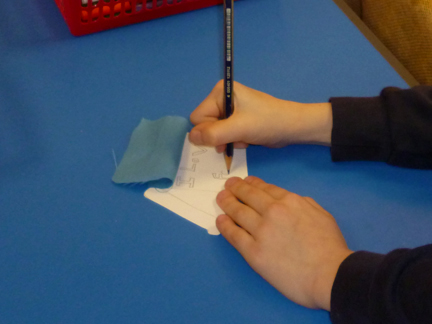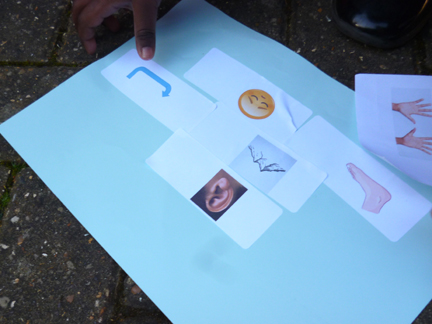Holy places"What makes a holy place?" was a question that fitted in well with the R.E. topic regarding places of worship. We held the event over two days and it was visited by three classes: a reception/Year 1 class, a mixed Year 1/2 class and a Year 3/4 class. After the introduction each class was divided into three groups that rotated around the stories before coming back together for a creative activity. To explore the idea of holy places we chose three different stories: The Godly Play story of the Ark and the Tent (a holy place that people carried around with them); the Psalms of Ascent, pilgrimage to Jerusalem (a holy place that people had to travel to visit) and the story of the local church (a holy place in their own community.) IntroductionWe began in the classroom and asked the children if they had a special place. Several responded by talking about their bedrooms, the garden or somewhere that they had visited on holiday. We then talked about how people who are religious and want to come close to God often have special places. We showed the class pictures of synagogues, Hindu temples, mosques, churches etc. We were careful to show a variety of different religions and also different sizes of places of worship (for example a small wayside Hindu shrine in India and Ely cathedral). The class then rotated around the different stories. 1 The Ark and the TentThis story was chosen as it showed that holy places or places of worship were not necessarily tied to one place or a particular building but could travel with the people. It was told using the Godly Play story, with the desert box, the walls to make the tent and small wooden symbols for the Ark, the seven branched lampstand, the incense burner, the table for the bread, the place of washing and the altar for the offerings. To cut down on clutter the bookshelves and equipment was covered with plain white cloths, hessian cloths and the desert backdrop painted by children at a community event. The only focus was the menorah, the seven branched lampstand.  Reflective questionsI wonder what you liked best? I wonder what you think is the most important? I wonder if we can take anything away and still have all the story that we need? I wonder if you are in this story? ActivitiesThe children were given a tent shaped piece of card and chose a piece of coloured cloth to stick on to create a tent. The children wrote or drew something special inside the tent. The children also had the opportunity to play with the desert box, the people of God and the wooden symbols. 2 The songs of ascent"The people of God would make a special journey once a year to worship God at the Temple. It was a long journey which took several days, but this gave them lots of time to get ready to worship God in the Temple. Let's get ready to go on the journey together." This session took place outside. The children began by walking around the playground and then climbed up two sets of steps to the grassy area. "The Temple in Jerusalem had some steps leading up to it. As the people travelled they thought about the steps they would climb. As they thought about each step it reminded them of another way to get ready to worship God in the temple. They sang a song for each step, to help them remember how to get ready to worship God in the Temple."  Seven steps were used for the songs of ascent. The children were encouraged to think about different things for each of these steps on their journey to worship God in the temple and a short verse was written for each. At each step the children were given a sticker to stick on their card. The seven steps were: things that make us sad; God keeping our feet from slipping; God made us feel as strong as mountains; choosing the path that leads to God; God hearing us as we got closer to him; feeling calm and quiet on arrival at the temple; worshipping God with our hands raised in the air. Each verse finished with a line about the temple: See the mountains big and strong, big and strong, big and strong, See the mountains big and strong We're on our way to the temple Reflective questionsI wonder which step you liked the best? I wonder which step you liked the least? ActivitiesThe story finished at "the temple" - the outside area under the tree with tables and benches. Here the children were reminded of the different steps and given the opportunity to decorate their cards. 3 The local church"Long, long, ago, about the year 1260, there was a village called Arden. One day someone, looked at the green hill on the edge of the village and was inspired. This would be a good place to build a church, they thought, a place for the people of Arden to come and be close to God. This church would be built of stone. It would be strong enough to last for years. Perhaps it would last for hundreds of years... The church has stood on the hill for 750 years. There have been easy years and difficult years, years of care and years of neglect, years of peace and years of danger..." We told the story of our local church through a series of stories and pictures - the woodcarver who carved a tiny swan, high up and almost invisible; the coming of the Puritans in 1644 and their destruction of crosses and statues because they wanted a simpler church; the years of neglect that so horrified the new rector in 1871... "Nothing ever stays the same. Even today the church is changing. When the church celebrated its 750th birthday the Brownies planted a crocus clock with the time set to 7.50." We talked about future changes (including the proposed loo installation!) and how everyone has their own ideas on the best way to worship God.  Reflective questionsI wonder which of these things you like the best? I wonder what changes you think there might be in the future? I wonder if there is something that needs to be in every church? ActivitiesEach child was given a candle out line and paintsticks, plastic gems, glitter etc to decorate it. They also chose five tiny photos of things that could be seen in the church. Ending and Creative responseWith the youngest class we brought them back together, reminded them of the stories and asked which part they liked the best. We then gave them a church window outline and invited them to use collage materials to decorate the window. Each child was also given a piece of model magic and asked to make a symbol of something that might be found in a holy place. When we regathered with the older two classes (5 - 9 year olds) we asked them what they thought was the most important part of the stories. We then asked the children to create their own place of worship, a place where someone might come close to God - or else a really quiet place, a place where people could come just to stop and think. They were given the opportunity to draw this special place or to use a selection of symbols and materials. These included shimmer stones, cloths, blocks, candles, flames, waves, crowns, crosses, flowers, birds and animals. When they had finished creating we asked them to sit in or near their special place while we played "Be still for the presence of the Lord is moving in this place." With the oldest children we asked a member of each group to pick something that they had included in their creation and say why they had chosen it. All groups had the opportunity to choose five little things to remind them of the stories and a drink and a biscuit. How well did it work?Even the youngest children engaged well with the stories. I had thought that the story of the Ark and the Tent might be too difficult for them but they were fascinated by the little things. The story of the songs of ascent, told on the move, provided a good contrast to the other stories. When asked how they would change their local church several suggestions focused on practical comfort: "put in some sofas". It was fascinating watching the children develop their ideas with regard to creating a place of worship or a place to be quiet. One child took a large cardboard box to create a quiet place just for himself. He labelled it "Andy's place of darkness and prayer" and when we played "Be still" he went inside it. Other children focused on themes such as light - one of the younger children created a dark place by throwing a black cloth over a table; they then filled the silver urn with tealights. Another group used all the flame and fire wooden symbols, while other groups seemed to have a strong creation theme. One child took all the baby dolls, lined them up in a row and placed crowns on their heads. I have no idea what this symbolised or what she was thinking. She may not have known herself but it came across as a very striking image. For some groups there was no discernible overall theme. I felt the question "Tell us about one thing that you have included and why you chose it" did not really work. It seemed that the children had created their place of worship intuitively, developing it as they went, rather than with a set ideas of what they wanted to do. This may have been partly due to the time factor - they only had about 15 minutes from start to finish. We did give the children time to go round and look at each others creations; another time I would ask them to comment on which one had helped them feel prayerful or which one was a good place to be quiet. With the middle group (5 to 7 year olds) we had laid out the cloths and symbols around the edge of the room. This meant that they had to make their creations in "free space" and it seemed to me they found this quite difficult. So for the final group (7 to 9 year olds) we placed the material in the centre of the room and suggested they chose a place around the edge. This seemed to work much better. Sarah(with thanks to Clare Reed, Rowena Berridge, Steph Cole and the team) |